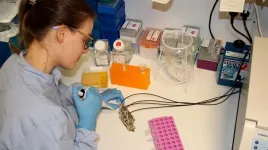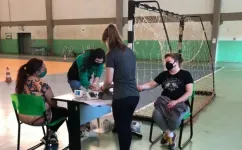University of Cincinnati screening program contributes to increase in HIV diagnoses
Emergency medicine study calls for expansion of patient testing
2021-06-30
(Press-News.org) Newly published research shows that a screening program in the University of Cincinnati Medical Center Emergency Department helped detect an outbreak of HIV among persons who inject drugs in Hamilton County, Ohio, from 2014-18.
The study was published in PLOS ONE.
The results of the study highlight UC contributions to public health surveillance as yet another reason why emergency departments should be screening for undiagnosed HIV infections, according to Michael Lyons, MD, associate professor in the Department of Emergency Medicine at the UC College of Medicine.
"The importance of emergency department screening has been established for over 20 years," says Lyons. "Diagnosing people as early as possible allows for changes in behavior to stop spreading the illness and treatment that improves their health and makes them much less infectious to others."
Since 2015, an increasing number of HIV outbreaks among those who inject drugs have been reported in the United States. The study found this single testing site contributed 20% of new HIV diagnoses regionally during a period of rapidly increasing HIV infection in that group.
An Early Intervention Program (EIP) was founded at UC in 1998, the first program of its kind in the country. The EIP offers HIV intervention/prevention counseling, testing, linkage to care and many other services to assist individuals.
"Everyone understands that early diagnosis of HIV is critical for individuals and public health," says Lyons. "Everyone knows that when you screen, that data goes into surveillance systems. This study highlights that a contribution to surveillance is an important public health outcome. In this case, it helped public health authorities to identify a serious HIV outbreak and trigger a Centers for Disease Control and Prevention investigation and response planning. That's not to say that we solved this public health problem, but your chances of helping are a lot better if you know about the crisis than if you don't."
The screening is done through a blood test or an oral swab. The blood test method is the most common, and the sample is sent to the lab, with results returned typically in 90 minutes. If the patient has been discharged, the emergency staff follows up with them later. The health department is notified of all positive results for surveillance and to facilitate partner counseling and referral services.
Lyons says the screening program at UC follows a few different program models. They have publicly funded health promotion advocates who are adjunct health care workers in the department who help with screening. There are also integrated screening workflows in the electronic health record where the nurses and providers are prompted to order testing as well.
Lyons and the other researchers would like to see this study have an impact on public health policy as well as the frequency of HIV screening in emergency departments across the country.
"I hope that public health and policymakers continue to realize that understanding disease epidemiology through surveillance data is essential for fighting infectious disease and that emergency department data is very important to those surveillance efforts," says Lyons. "I also hope that emergency departments are even more motivated to expand HIV screening given their role in monitoring trends in epidemiology that guide public health response."
Study authors included representatives from the Centers for Disease Control and Prevention, the Ohio Department of Health and Hamilton County Public Health.
INFORMATION:
[Attachments] See images for this press release:

ELSE PRESS RELEASES FROM THIS DATE:
2021-06-30
Some people casually smoke cigarettes for a while and then stop without a problem, while others develop long-term, several packs-per-day habits. A complex mix of environmental, behavioral and genetic factors appear to raise this risk for nicotine dependence.
Studies of groups of twins suggest that 40 to 70 percent of the risk factors are heritable. Until recently, however, studies have only explained about 1 percent of the observed variation in liability to nicotine dependence, using a genetic score based on how many cigarettes a person smokes per day.
A new study led by psychologists ...
2021-06-30
Using an experimental model to simulate the blood-brain barrier, scientists in Sweden reported in unprecedented detail how antioxidants protect the brain from inflammation caused by neurodegenerative diseases such as Alzheimer's and Parkinson's.
The study, conducted as a proof of concept by brain model developers at KTH Royal Institute of Technology in Stockholm, showed in minute-by-minute detail how the blood-brain barrier reacts to high levels of inflammation after the administration of a next-generation derivative of the widely-used anti-inflammatory drug, NAC (N-acetylcysteine).
The testing of NACA (N-Acetylcysteine Amide) for the first time with ...
2021-06-30
A new way to target a mutant protein which can cause the deadliest of cancers in humans has been uncovered by scientists at the University of Leeds.
The mutated form of the RAS protein has been referred to as the "Death Star" because of its ability to resist treatments and is found in 96% of pancreatic cancers and 54% of colorectal cancers.
RAS is a protein important for health but in its mutated form it can be switched on for longer, leading to the growth of tumours.
One drug has already been approved for treatment but it can only tackle a small subset of ...
2021-06-30
In a study involving 34 women aged 50-70, researchers at the University of São Paulo (USP) in Brazil performed objective measurements of the impact on the subjects' health of the decrease in physical activity observed during the period of social distancing and isolation imposed by COVID-19. Tests conducted after the first 16 weeks of confinement pointed to a deterioration in their overall health, including loss of muscle strength and diminished aerobic capacity, as well as elevated levels of cholesterol and glycated hemoglobin, both of which are risk factors for metabolic disorders.
The study was supported by São Paulo Research Foundation ...
2021-06-30
When it comes to understanding and predicting trends in energy use, the internet is a tough nut to crack. So say energy researchers Eric Masanet, of UC Santa Barbara, and Jonathan Koomey, of Koomey Analytics. The two just published a peer-reviewed commentary in the journal Joule discussing the pitfalls that plague estimates of the internet's energy and carbon impacts.
The paper describes how these errors can lead well-intentioned studies to predict massive energy growth in the information technology (IT) sector, which often doesn't materialize. "We're not saying the energy use of the internet isn't a ...
2021-06-30
CHAMPAIGN, Ill. -- The chance of detecting the virus that causes COVID-19 increases with more frequent testing, no matter the type of test, a new study found. Both polymerase chain reaction and antigen tests, paired with rapid results reporting, can achieve 98% sensitivity if deployed at least every three days.
"This study shows that frequent testing can be really effective at catching COVID-19 infections and potentially blocking transmission," said study leader Christopher Brooke, a virologist and professor of microbiology at the University of Illinois Urbana-Champaign. "There are many places where vaccination is not yet widespread. With the rise of variants, testing remains an important tool ...
2021-06-30
QUT researchers have developed a new machine learning mathematical system that helps to identify and detect changes in biodiversity, including land clearing, when satellite imagery is obstructed by clouds.
Using statistical methods to quantify uncertainty, the research, published in Remote Sensing in Ecology and Conservation, analysed available satellite images of an 180km square area in central south-east Queensland.
The region is home to many native species including the critically endangered northern hairy-nosed wombat and the vulnerable greater glider, and the ...
2021-06-30
Fossilized feces are common finds at paleontological dig sites and might actually contain hidden treasures. By scanning fossilized dung assigned to a close dinosaur relative from the Triassic period, scientists discovered a 230-million-year-old beetle species, representing a new family of beetles, previously unknown to science. The beetles were preserved in a 3D state with their legs and antennae fully intact. The finding appears June 30 in the journal Current Biology.
The discovery that fossilized droppings, also known as coprolites, can preserve ancient insect species offers a new alternative to amber fossils--fossilized tree resin, which normally yield the best-preserved insect fossils. The oldest ...
2021-06-30
Don't let the great snipe's pudginess fool you. A stocky marsh bird with a 20-inch wingspan, great snipes are also speedy marathoners that can migrate from Sweden to Central Africa in just three days, without even stopping to eat, drink, or sleep. Now, researchers find that the snipes also rise nearly 2,500 meters in elevation at dawn and descend again at dusk each day, perhaps to avoid overheating from daytime solar radiation by climbing to higher, cooler altitudes. The findings appear June 30 in the journal Current Biology.
The birds also spent much more time in higher elevations ...
2021-06-30
Election outcomes are notoriously difficult to predict. In 2016, for example, most polls suggested that Hillary Clinton would win the presidency, but Donald Trump defeated her. Researchers cite multiple explanations for the unreliability in election forecasts -- some voters are difficult to reach, and some may wish to remain hidden. Among those who do respond to surveys, some may change their minds after being polled, while others may be embarrassed or afraid to report their true intentions.
In a new perspective piece for END ...
LAST 30 PRESS RELEASES:
[Press-News.org] University of Cincinnati screening program contributes to increase in HIV diagnoses
Emergency medicine study calls for expansion of patient testing





